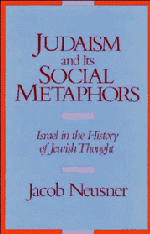Book contents
- Frontmatter
- Contents
- Preface
- List of Abbreviations
- Introduction
- 1 Imagining Society, Re-visioning “Israel”
- PART I “Israel” in the First Statement of Judaism, 70–300 C.E.
- PART II “Israel” in the Second Statement of Judaism, 300–600 C.E.
- PART III Same Metaphors, Other Systems
- General Index
- Index to Biblical and Talmudic References
1 - Imagining Society, Re-visioning “Israel”
Published online by Cambridge University Press: 04 August 2010
- Frontmatter
- Contents
- Preface
- List of Abbreviations
- Introduction
- 1 Imagining Society, Re-visioning “Israel”
- PART I “Israel” in the First Statement of Judaism, 70–300 C.E.
- PART II “Israel” in the Second Statement of Judaism, 300–600 C.E.
- PART III Same Metaphors, Other Systems
- General Index
- Index to Biblical and Talmudic References
Summary
Imagining Society
We do not experience but only imagine “society,” because “society” viewed whole is something too abstract and remote from everyday life to afford a concrete encounter. We know individual people. But we generalize and so in our minds conceive, or imagine, that the concrete persons we encounter represent or form part of that abstraction, society. Thus we make sense of the world beyond the here and the now of everyday life. We move from what we know, the concrete and immediate, to what we do not know. Whatever lies beyond our experience, encompassing all modes of abstraction and all conceptions of not merely event but process, demands to be set into relationship with what we already know. Connections that we make, abstractions that we perceive only in their concrete manifestations, processes that we can imagine but not identify – not the blow but power, not the caress but love – these form the raw material of mind. Accordingly, when we name and treat as real and concrete what are in fact abstractions and intangible processes, we impose upon ourselves the need to compare the abstract to the concrete. We therefore think in a process of analogy, contrast, comparison, and metaphor about something that, to begin with, we ourselves have identified and so made up in our minds.
Take a group, for example. When two or more persons perceive themselves to bear traits in common and to constitute a group on account of those indicative traits, they face a range of choices in thinking about the classification and character of that social entity that they imagine they compose.
- Type
- Chapter
- Information
- Judaism and its Social MetaphorsIsrael in the History of Jewish Thought, pp. 8 - 18Publisher: Cambridge University PressPrint publication year: 1989



